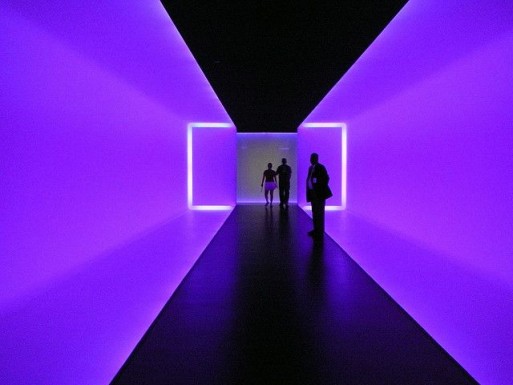Artist James Turrell (b. 1943, Los Angeles) played a pivotal role in the West Coast’s Light and Space Movement during the 1960s and 70s. The movement was rooted in the flexibility of perception and manipulation of space, and Turrell’s pieces targeted the viewer’s senses like homing darts, enveloping him or her in an environment seeming to exist outside of space and time. Not that long ago, I visited the Los Angeles County Museum of Art (LACMA) and saw Turrell’s “Breathing Light,” which I could only describe as a masterpiece of purple — a visceral space created by violet light that, oddly enough, created the perfect atmosphere to ponder death.
“Turrell’s work, by pushing the limits of our own perception and physical norms, becomes a hot spot for existential thoughts. Indeed, for being such contemporary works, Terrell’s “lights” feel timeless, creating a spiritual atmosphere.”
Turrell’s work, by pushing the limits of our own perception and physical norms, becomes a hot spot for existential thoughts. Indeed, for being such contemporary works, Turrell’s “lights” feel timeless, creating a spiritual atmosphere. If you ever have the chance to visit one of his works, take it as an opportunity to have a conversation with yourself about life, death and your attachment to the physical world.
“I was maybe 5 or 6, and my grandmother would begin sitting me in the Quaker meeting house. I asked my grandmother, ‘What am I supposed to do?’ and she said, ‘Just wait, we’re going inside to greet the light.’ I liked that—this idea to go inside to find that light within, literally as well as figuratively.”
— James Turrell
Look closely, and you’ll find that light loves to take center stage in innovative art. The impressionists revolutionized the French Salon scene with their sun-drenched landscapes. Similarly, albeit much later, David Hockney transported viewers to California with his blinding, delicious pools. What all of these works and movements have in common is the desire to bring emotion into art, to move past the unfeeling goal of merely depicting something to instead start a conversation within us.
Stepping into one of Turrell’s works almost feels like stepping into the afterlife, or a rather hip mausoleum. A strange, comforting sense of unity and anonymity is created for the viewers, who are all bathed in the same light. It’s as if Turrell knows something about the connection between the physical and the “great beyond” (whatever that may be) that we don’t – but we sure are glad he’s willing to share it with us.

 Breathing Light: James Turrell at LACMA
Breathing Light: James Turrell at LACMA





 “As Tears Go By” by Marianne Faithfull
“As Tears Go By” by Marianne Faithfull
 “The Sea” by John Banville
“The Sea” by John Banville
 Funeral Favors Offer Visitors a Tangible Memento
Funeral Favors Offer Visitors a Tangible Memento















